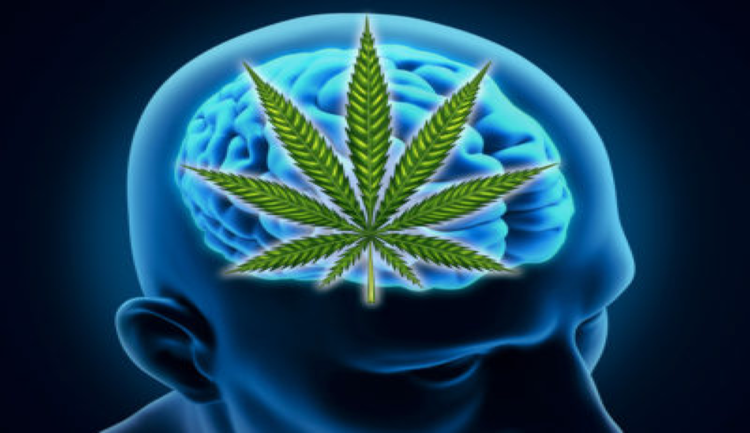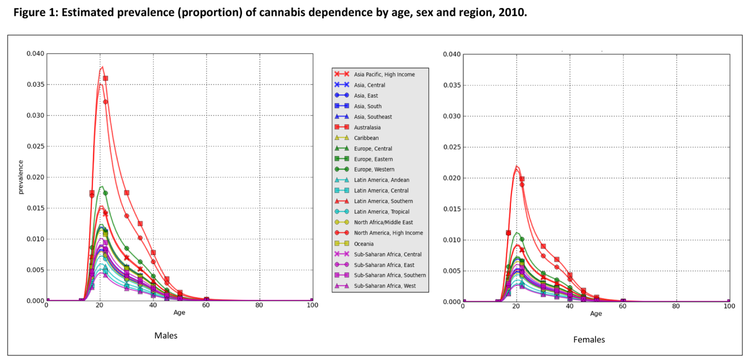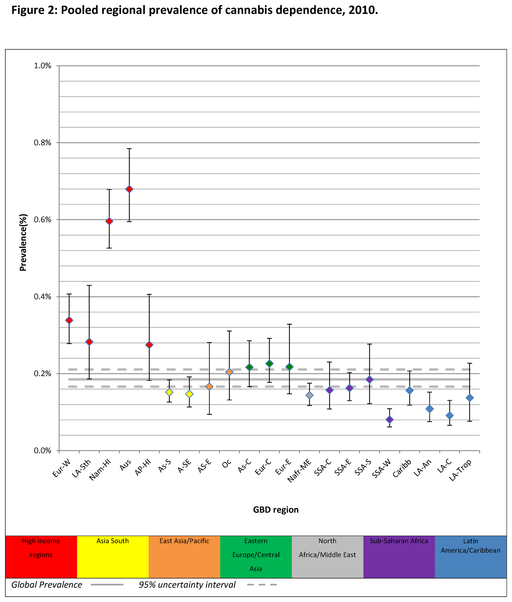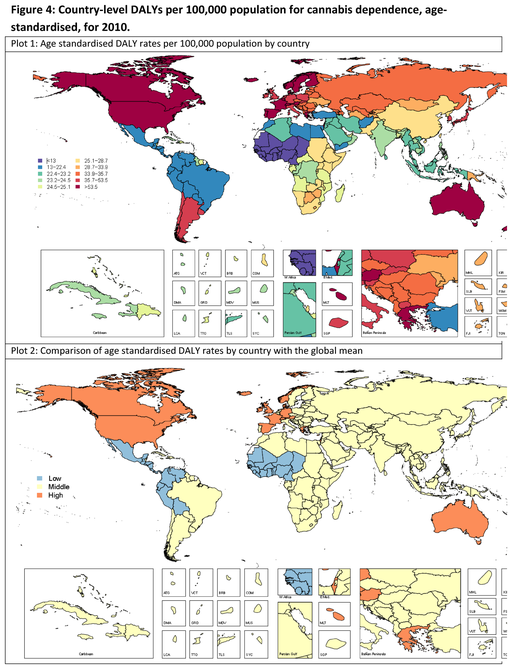This is an old revision of the document!
Table of Contents
INTRODUCTION
CANNABIS CONSUMPTION
CANNABIS USAGE
MEDICINAL
SPIRITUAL
RECREATIONAL
EPIDEMIOLOGY
In 2012, 43% of Canadians reported that they had used marijuana at some time in their lives, and 12% reported using it in the past year (Statistics Canada, 2013). Marijuana use was more common among males than females (Statistics Canada, 2013). People aged 18 to 24 had the highest prevalence of past-year marijuana use, and tended to use it more frequently than did people of other ages (Statistics Canada, 2013).
In Canada, as in many other countries, marijuana is the most commonly used illicit drug (Statistics Canada, 2013).
Throughout the world the prevalence was higher in males than females, resulting in an average male:female sex ratio of 1.8 (Degenhard et al, 2013). Prevalence peaks worldwide in the 20-24 years age group at between and then steadily decreasing after that age group thereafter (Degenhard et al, 2013).
Figure ##: Pooled regional prevalence of cannabis dependence, 2010. Note. Prevalence estimates were standardised by population age and sex; AP-HI: Asia Pacific, High Income, As-C: Asia Central, AS-E: Asia East, AS-S: Asia South, A-SE: Asia Southeast, Aus: Australasia, Caribb: Caribbean, Eur-C: Europe Central, Eur-E: Europe Eastern, Eur-W: Europe Western, LA-An: Latin America, Andean, LA-C: Latin America, Central, LA-Sth: Latin America, Southern, LA-Trop: Latin America, Tropical, Nafr-ME: North Africa/Middle East, Nam-HI: North America, High Income, Oc: Oceania, SSA-C: Sub-Saharan Africa, Central, SSA-E: Sub-Saharan Africa, East, SSA-S: Sub-Saharan Africa Southern, SSA-W: Sub-Saharan Africa, West. (Degenhard et al, 2013)
Prevalence in high income regions was much higher than that in low to middle income regions and the global average (Degenhard et al, 2013). Cannabis dependence in Australasia is about 8 times higher than prevalence in Sub-Saharan Africa, West (Degenhard et al, 2013).
Figure ##: Country-level DALYs per 100,000 population for cannabis dependence, age-standardised, for 2010. Note. Low: shows countries with statistically lower DALY rates than global mean; Middle: Shows countries with DALY rates that are not statistically different to global mean; High: Shows countries with statistically higher DALY rates than global mean. (Degenhard et al, 2013)
Worldwide, DALYs are closely associated with high income countries having more effected years compared to those of low income countries (Degenhard et al, 2013). The statistical DALY rates are comparably higher than the global mean in higher income countries than lower income (Degenhard et al, 2013).
SHORT-TERM EFFECTS
LONG-TERM EFFECTS
MECHANISM OF ACTION
EFFECTS OF MARIJUANA ON THE BRAIN VIDEOS
EFFECTS OF MARIJUANA ON THE BRAIN POWERPOINT
References
Abush, H., & Akirav, I. (2012). Short-and long-term cognitive effects of chronic cannabinoids administration in late-adolescence rats. PLoS One, 7(2), e31731.
Ameri, Angela. “The Effects Of Cannabinoids On The Brain”. Progress in Neurobiology 58.4 (1999): 315-348. Web.
Block, R. I., O'leary, D. S., Ehrhardt, J. C., Augustinack, J. C., Ghoneim, M. M., Arndt, S., & Hall, J. A. (2000). Effects of frequent marijuana use on brain tissue volume and composition. Neuroreport, 11(3), 491-496.
Bolla, K. I., Brown, K., Eldreth, D., Tate, K., & Cadet, J. L. (2002). Dose-related neurocognitive effects of marijuana use. Neurology, 59(9), 1337-1343.
Bonsor, K., & Gerbis, N. (2001). How Marijuana Works. Retrieved April 02, 2017, from http://science.howstuffworks.com/marijuana3.htm
Borgelt, L. M., Franson, K. L., Nussbaum, A. M., & Wang, G. S. (2013). The pharmacologic and clinical effects of medical cannabis. Pharmacotherapy: The Journal of Human Pharmacology and Drug Therapy, 33(2), 195-209.
Brock, Tom. “CANNABINOID SIGNALING: THE ORIGINAL RETROGRADE SIGNALING PATHWAY”. Caymanchem.com. N.p., 2008. Web. 2 Apr. 2017.
Deem, R. (2013). The Medical “Benefits” of Smoking Marijuana (Cannabis): a Review of the Current Scientific Literatureby Rich Deem. Retrieved April 01, 2017, from http://www.godandscience.org/doctrine/medical_marijuana_review.html
Degenhardt, Louisa, Alize J. Ferrari, Bianca Calabria, Wayne D. Hall, Rosana E. Norman, John Mcgrath, Abraham D. Flaxman, Rebecca E. Engell, Greg D. Freedman, Harvey A. Whiteford, and Theo Vos. “The Global Epidemiology and Contribution of Cannabis Use and Dependence to the Global Burden of Disease: Results from the GBD 2010 Study.” PLoS ONE 8.10 (2013): n. pag. Web.
Filbey, F. M., Aslan, S., Calhoun, V. D., Spence, J. S., Damaraju, E., Caprihan, A., & Segall, J. (2014). Long-term effects of marijuana use on the brain. Proceedings of the National Academy of Sciences, 111(47), 16913-16918.
Hendershot, C. S., Magnan, R. E., & Bryan, A. D. (2010). Associations of marijuana use and sex-related marijuana expectancies with HIV/STD risk behavior in high-risk adolescents. Psychology of Addictive Behaviors, 24(3), 404.
H. (2015, September 17). The Effects Of Weed On Your Health. Retrieved April 01, 2017, from http://herb.co/2015/09/17/the-effects-of-weed-on-your-health/ Iversen, L. “Cannabis And The Brain”. Brain 126.6 (2003): 1252-1270. Web.
Osborne, G. B., & Fogel, C. (2008). Understanding the motivations for recreational marijuana use among adult Canadians. Substance use & misuse, 43(3-4), 539-572.
“The Science Of Marijuana: How THC Affects The Brain”. Headsup.scholastic.com. N.p., 2011. Web. 2 Apr. 2017.
“The Science Of The Endocannabinoid System: How THC Affects The Brain And The Body”. Headsup.scholastic.com. N.p., 2011. Web. 2 Apr. 2017.
“Prevalence and correlates of marijuana use in Canada, 2012.” Government of Canada, Statistics Canada. N.p., 27 Nov. 2015. Web. 02 Apr. 2017.
Vathi, Sonila. “Endocannabinoid System: Key Regulatory Enzymes And Physio-Pathological Implications”. Flipper.diff.org. N.p., 2014. Web. 2 Apr. 2017.
Short- & Long-Term Effects of Marijuana - Negative Side Effects of Weed - Drug-Free World. (n.d.). Retrieved April 01, 2017, from http://www.drugfreeworld.org/drugfacts/marijuana/short-and-long-term-effects.html



